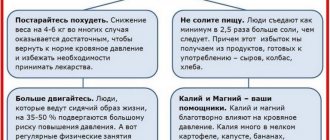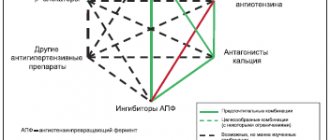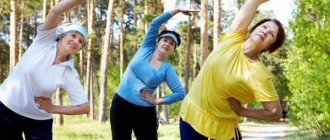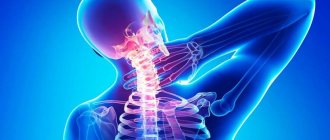Light breathing exercises
Breathing exercises to lower blood pressure help almost all hypertensive patients; it can saturate the body with oxygen, strengthens the heart and vascular system, and can speed up metabolic processes in the body.
If your blood pressure starts to rise, doctors recommend starting with simple activities:
Take a big breath and hold your breath for 15 seconds.- Exhale slowly.
- After 30 seconds, repeat, but hold your breath 5 seconds longer each time.
- Do about 10 repetitions.
Such exercises should be combined with exercises to normalize the condition and reduce blood pressure. In a simplified version of gymnastics, you need to take a lot of breaths. The start of therapy is 10 minutes, 80 breaths are taken. After a few days, you need to increase the number of breaths and time. After 60 days there should be about 5000 breaths per hour. This complex should be carried out 2 times a day.
Exercises according to Strelnikova
Strelnikova’s course helped many hypertensive patients to steadily reduce and normalize blood pressure. All types must be done from a standing position and performed in turn. Repeat each exercise about 6-8 times, but over time the number should increase.
During all movements, breathing should be sharp, and also include many short inhalations and long exhalations.
The full course for hypertension is as follows:
Palms. You need to spread your arms to the sides, bend them so that they are vertical to the floor, and turn your palms away from you. Clench your fists while taking strong but small breaths. Take one big exhale and repeat the exercise up to 6 times. A pause is made for 10 seconds and everything is repeated up to 8 times.- Shoulder straps. Bend your arms at the waist, clench your palms into fists. Taking a strong breath, lower your arms down and unclench your palms with your fingers spread as far apart as possible. Do 8 repetitions without rest, then pause for 10 seconds. Number of approaches up to 8 times.
- Pump. Relax your arms and shoulders, lower them to the floor as much as possible. Bend slowly down and inhale with a sound, and then exhale and straighten up. Repeat 12 times, rest for 5 seconds.
- Hug your shoulders. Bend your arms in front of you, make a lock, your right palm should be directed towards the floor and located under your left elbow. While inhaling quickly, hug yourself, exhale calmly and take the starting position. Repeat 8 times for 9 approaches with an interval of 10 seconds.
- Turn your head. You need to turn your head to the sides, while sharply inhaling air. You can exhale arbitrarily with your mouth open. The exercise involves 8 repetitions with 12 approaches for each side with an interval of 4 seconds.
- Pendulum. Take the bottom position from the “Pump” exercise and do the “Hug your shoulders”. Repeat 8 times for 8 approaches, at intervals of 10 seconds.
By doing the described exercises for hypertension every day, you can ensure that high blood pressure levels decrease. Results appear within a week of the complex.
Exercises according to Bubnovsky
This type of exercise is suitable for lowering blood pressure at home. Starting position - on all fours, resting on your palms and knees. You need to bend your back.
The rest of the set of exercises is carried out from the described position:
- You need to sit on your left leg, bending it, and pull your right leg back. The left leg is extended as far forward as possible so that the body lowers closer to the floor. During movements, you need to include your right hand on your left leg, then vice versa. Inhalations are carried out at the last points. 20 movements are performed at a time.
- It is necessary to stretch your back, but the starting position should be on your elbows, not your palms. As you exhale, lower your body to the floor, while inhaling, straighten your arms, trying to stand on your heels. Exercise reduces blood pressure and strengthens the muscles of the back and lower back. The number of repetitions should be 6 times.
You cannot rely solely on the described complex for hypertension. In severe cases, you cannot do without pills, so the doctor’s advice should not be neglected.
- Therapeutic gymnastics by Evdokimenko for hip joints: video exercises
Exercises according to Buteyko
This complex is also based on breathing exercises; the essence is to use 3 basic exercises, which should be alternated between dynamic and calm ones:
- Hold the breath. The essence of the exercise is an artificial lack of air. The breath is held for 10 seconds, after which small breaths are taken for 1-2 minutes.
- Hold your breath while walking. It is necessary to hold your nose with your fingers and not breathe for as long as possible. After breathing normalizes, you need to repeat the exercise about 3 times.
- Shallow breathing. You need to sit down and relax your diaphragm. Breathing is carried out very easily through the nose, in a normal rhythm, for 3 minutes. Deep breaths are prohibited during the exercise.
This complex makes it possible to relieve high blood pressure within a week.
Qigong exercise
This method is very old, it is a Tibetan method of reducing blood pressure, which can be used for different types and degrees of hypertension. Exercises are best suited for primary hypertension, which is an independent pathology, without additional complications. During the exercise, blood circulation improves due to the renewal of oxygen and carbon dioxide. If you use the complex for 6 months, then stable pressure appears within the normal range or close to that value. Most often, patients report complete improvement.
To perform the exercises correctly, you need to know all the rules:
- When breathing, the chest should not move; diaphragmatic breathing is used accordingly.
- When you inhale, the abdominal cavity inflates, and when you exhale, it retracts.
- The spine and head should be in a straight line.
- All exercises should be performed at rest.
- The complex is selected based on the condition of the hypertensive patient, taking into account the physical level of training.
- The time and number of exercises should be gradually increased.
- To permanently reduce and normalize blood pressure, you need to carry out exercises on an ongoing basis, persistently.
The Qigong method includes many exercises, but there is no point in using the full complex, because not all types help with hypertension. If you suffer from high blood pressure, you should use only some common types, which are divided into basic and additional.
Basic exercises to reduce blood pressure include:
- Relaxation. Allows you to find harmony of the heart. The entire body must be visually divided into 3 parts. The first includes the side part of the head, neck and arms, the second includes the front part of the body from the lower part of the face to the legs, and the last includes the bottom of the back of the head to the heels. Take a comfortable sitting or standing position, you need to concentrate on all areas and say “relaxed” to yourself. When complete relaxation begins, you will need to concentrate on the groin area and gradually come out of relaxation. Carry out up to 4 similar exercises.
- Pillar. Place your feet shoulder-width apart and place your hands on your belt. Just breathe for about 3 minutes, and then do the first exercise.
- Hug the ball. You need to lie on a flat surface and bend your legs, and hug an imaginary circle with your arms. Try to relax as much as possible.
- The work of thought. After the previous exercise, you need to work on the main idea. If you have high blood pressure, it is recommended to imagine a bath and the sounds of water. Breathe naturally.
A full set of basic exercises takes about 10 minutes, but over time you need to increase the period. The described methods should be used 2-5 times a day. Conditions should be comfortable.
You also need to use additional exercises, which can be done at any convenient time. To effectively reduce pressure you need:
- Point massage the sole.
- Perform a lower back massage.
Constantly following the described course with concentration on exhalations should normalize the functioning of the nervous system, due to which the pressure decreases.
- A set of exercises for coxarthrosis of the hip joint: treatment at home
For hypertension, you can use a complex of 6 words. The entire course will take about an hour and for lasting results it is better to do it 2 times a day. You need to stand, join your arms along your body and concentrate on breathing (inhalation).
While exhaling, make sounds:
- Su.
- Heh.
- Hu.
- Si.
- Chuy.
- Si.
The respiratory complex is useful not only for hypertension, but also for the whole body. The described remedies can stabilize blood pressure, improve well-being and general condition, and also have a positive effect on the functioning of the heart.
What is blood pressure (BP) and how is it formed?
BP = CO * OPSS
Where is NE
- cardiac output - the amount of blood that the heart pumps into the vascular system in 1 minute.
OPSS
- general peripheral vascular resistance - small arteries that have a developed muscle layer, the contraction of which causes a narrowing of the vascular walls, increasing the level of resistance and increasing blood pressure. Vascular tone directly depends on the work of the sympathetic and parasympathetic nervous system.
CO = HR * SV
Where is the heart rate
- number of heartbeats per 1 minute. Heart rate directly depends on the work of the sympathetic and parasympathetic nervous system.
UO
- stroke volume is the volume of blood that the left ventricle throws into the circulatory system in one contraction. SV depends, firstly, on how fully the heart can relax after contraction, and secondly, on the total volume of circulating blood. If the blood volume is small, the heart has nothing to fill with. During bleeding, SV decreases, as a result, CO decreases, which leads to a decrease in blood pressure.
Circulating blood volume (CBV) depends on the amount of fluid in the body, which, in turn, depends on the amount of water that enters and leaves the body. Where does water come from in the body? Each person's body contains about 400 ml. metabolic (endogenous) water. We get extra from what we eat and drink.
The main route of fluid excretion is through the kidneys. If the kidneys excrete less fluid, then BCC and, accordingly, CO will increase, which will lead to an increase in blood pressure; if the kidneys excrete more fluid, then BCC and CO will decrease, leading to a decrease in blood pressure. Therefore, one of the ways to lower blood pressure is to use diuretics.
Dr. Strelnikova’s complex against hypertension
Doctor Strelnikova, whose methods have long been used by modern cardiologists, also recommended lowering blood pressure with exercises. To achieve tangible results, you need to do gymnastics regularly every day. The course is 2 months.
The basis of the technique is correct breathing.
- Palms. Stand up, fold your arms so that your palms are at shoulder level. Turn your palms forward. Take a powerful breath through your nose, while clench your fists. Exhale and loosen your hands again.
- Shoulder straps. Bend your arms so that your fists are at shoulder level. Inhale loudly, lowering and straightening your arms. Exhale, and enter the I.P.
- Horse. IP - any comfortable position in which the back remains level. Relax, take 4 deep breaths through your nose without interruption. Hold your breath for a couple of seconds and slowly return to the starting position.
- Pump. Place the legs at shoulder level. Bend over so that your back is slightly rounded. Inhale the air forcefully, straighten up, and only then exhale.
- The cat exercise is performed while standing. Bend your elbows and place your palms behind you at lower back level. Take a deep breath and turn to one side. Turn back and exhale calmly. Repeat everything from the beginning, but for the other side. At the same time, breathe noisily and deeply.
- Pendulum. Inhale and bend forward. As you exhale, straighten up and hug yourself with your arms. Turn your neck first in one direction and then in the other. Inhale during the turn, exhale during the starting position.
- Ears. Tilt your head towards one of your shoulders. While bending over, take a deep, powerful breath. Exhale while straightening your neck.
- Pendulum head. Inhale, while tilting your head forward, and as you exhale, return to the i.p.
Interesting! When performing exercises to normalize pressure according to the Strelnikova system, you should pay special attention to proper breathing. Inhalation is done through the nose and exhalation through the mouth. All actions should be performed about 6-8 times. With adaptation to loads, you can increase the number of repetitions. If your health deteriorates, it is better to temporarily interrupt exercise therapy.
Material on the topic: What exercises can you do after a heart attack.
Exercise therapy complex for normalizing blood pressure using the Buteyko method
Exercise therapy for hypertension, which was proposed by the doctor and scientist Konstantin Buteyko, has an extremely beneficial effect on the body: it saturates the organs with oxygen, strengthens blood vessels, and improves blood flow.
Important! According to Buteyko’s observation, the complex will help the patient completely get rid of the disease. Physical exercise normalizes the relationship between the volume of carbon dioxide and oxygen in the body.
Main rules of implementation:
- Gymnastics is performed while sitting, the body is relaxed, and the gaze is directed upward.
- Inhale through your nose, exhale through your mouth, breathe evenly, do not use the full volume of your chest.
- If you feel short of breath, take a deep breath.
If the execution goes correctly, a feeling of spreading warmth appears throughout the body, which intensifies with each new activity.
Exercises for high blood pressure are performed on an empty stomach. You need to inhale as silently as possible through your nose:
- Breathing is performed from the upper part of the lungs. Inhale and exhale for 5 seconds, then take a break for 5 seconds (do not breathe). Complete 10 repetitions in total.
- Breathe with your stomach and chest. At the same time, you can visually observe the movements of the chest and abdomen. Just 8 seconds to perform, and 5 seconds to rest (hold your breath). Perform 10 repetitions.
- Hold your breath for 7-10 seconds and massage your nose.
- Breathe 20 times on each side of your nose.
- Take in the air, pull in your stomach for 8 seconds, exhale, returning to IP for 8 seconds. Pause for 5 seconds and repeat everything from the very beginning 10 times.
- Do 12 powerful inhalations and exhalations in a minute. As you exhale for the last time, hold for 5 seconds. Return to i.p.
What physical exercises can be done for hypertension?
A physiotherapist or rehabilitation specialist will help you choose a set of exercises for hypertension.
- Walking _ There are various variations of this exercise: regular steps, on toes, on heels. These types can be alternated. Perform the steps for about five minutes.
- Bike . Sit on a chair and rest your hands. Raise your legs and imitate riding a bicycle. Perform the exercise in several approaches, but no more than five, and be sure to rest between them.
- Tilts . Sit on a chair, cross your arms over your chest. Pull your shoulders back, and as you exhale, bend your torso forward, trying to reach your heels with your hands. Perform all actions smoothly, do not bend over too sharply and avoid a low head position so as not to provoke a sharp rise in pressure.
- Sitting on a chair with a high back so that there is a fulcrum for the head. Move your arms slightly away from your body. Start rotating with relaxed arms from the elbow - first inward and then outward. Repeat the circular movements 20 - 25 times. Raise your arms a little higher and now perform rotations in the same way, but starting from the shoulders. This exercise stimulates peripheral circulation.
- Sitting on a chair, spread your arms to the sides. Lift your legs one by one and pull them towards your body with your hands. Repeat five times.
And also read on our website: What is nocturnal hypertension? Symptoms, treatment and prevention of the disease
- Therapeutic gymnastics for arthrosis of the hip joint - a set of exercises
We invite you to watch a video about what physical exercises you should do for hypertension:
If your heart hurts
For many people, spikes in blood pressure are accompanied by stabbing pain in the heart. Elderly patients especially often complain about this serious problem. There is a simple method for relieving cardiac colic, borrowed from another Eastern healing practice - acupuncture.
Surely you know that on the human body there are hundreds of special points associated with certain organs. By influencing the point, you can stimulate the functioning of the organ. So, the top of our left little finger is responsible for our heart. If you feel pain in your heart, gently massage your little finger with circular movements of your fingers and press on the base of the nail. Even the military and intelligence agencies use this technique, for example, when a comrade is wounded and help is delayed.
Benefits of physical activity
By performing simple physical therapy exercises, you can highlight the positive aspects for your health:
- Simple exercises help normalize the functioning of the heart and blood vessels, and increase the capabilities of the respiratory system. The elasticity of blood vessels improves, and the amount of “bad” cholesterol decreases.
- Metabolic processes are improved, harmful metabolic products are eliminated faster, and the load on the kidneys is reduced.
- The immune system is strengthened, which is also the prevention of seasonal colds.
- Thanks to deep and rapid breathing during exercise, lung ventilation improves.
- Exercising is an excellent way to prevent constipation.
- Fat tissue is gradually replaced by muscle tissue, and weight returns to normal.
- Increasing physical activity promotes healthy sleep and prevents stress.
- Joints become more elastic, bones become stronger.
- Memory improves by improving oxygen supply to the brain.
- Women endure menopause more easily, while men maintain potency throughout their lives.
Symptoms of High Blood Pressure
- Dizziness.
- Facial redness.
- Headache.
- Increased fatigue.
- Nosebleeds.
- Increased excitability.
What dangers does high blood pressure pose? Hypertensive crisis is a sharp increase in blood pressure with increased symptoms. However, more often high blood pressure is asymptomatic, which increases the risk of possible complications in the form of target organ damage, such as:
- Brain (stroke).
- Heart (myocardial infarction and heart failure).
- Kidneys (renal failure).
- Eyes (retinal hemorrhage and blindness).
Stages of hypertension (HT)
- Stage 1 headache: no changes in target organs.
- Stage 2 headache: changes in the O-M structure occurred without functional impairment (left ventricular hypertrophy, deformation of the fundus vessels, etc.).
- Stage 3 hypertension: O-M damage with functional impairment (stroke, myocardial infarction, renal failure, etc.).
When is hospitalization and oxygen support needed?
- If the indicator has dropped to 93% and the patient feels unwell (hypoxemia, respiratory failure, respiratory symptoms are severe).
- With a significant percentage of lung damage on CT (> 50%, with CT-3, CT-4).
- Old age of the patient.
- Concomitant chronic diseases of the respiratory system.
- Concomitant chronic diseases of the cardiovascular system.
- Initially low saturation due to anemia.
- Pregnant women.
- Patients with immunodeficiency.
- Obese patients.
- For diabetes mellitus.
A decrease in saturation is dangerous primarily for these groups of patients.
If a hospitalized patient's saturation is low and does not rise even with oxygen, then, according to the current recommendations of resuscitators, the patient undergoes tracheal intubation.
Exercise therapy after hernia removal
To recover normally after removal of a spinal hernia, you cannot do without physical therapy. Rehabilitation takes place in several stages:
- The first two weeks after surgery. The patient stays in the hospital, must wear a corset, and undergo medication treatment. You can get up for 2-3 days, sitting is not recommended. It is forbidden to lift weights exceeding 3-5 kg, and you cannot do massage.
- 2-6 weeks. The patient is discharged from the hospital. He must go to the clinic for physiotherapeutic procedures. You can't sit or stand for a long time yet. Weight no more than 8 kg.
- 1.5-2 months after operation. The attending physician prescribes exercise therapy and massage.
- 2-6 months The doctor allows you to increase the load when performing exercise therapy. Lifting weights and overworking is still not an option.
- After 6 months You need to take a course of exercise therapy on special simulators.
Thus, after the operation, the patient is almost motionless for the first two weeks. During this time, the muscles weaken and slightly atrophy. Your doctor will tell you when to start therapeutic exercises. Typically, exercise therapy is prescribed from 6 weeks after surgery. Activities at this time are the same as during the treatment of a hernia, depending on the location of the protrusion. But you can increase the load only by the doctor’s decision.
Read about all methods of treating hernias in our article “Treatment of intervertebral hernia.”
When you can’t do exercises after removal
After removal of a hernia, exercise therapy must be prescribed by a doctor, and the patient must strictly follow his instructions.
For the first time after surgery, you need to wear a corset, which helps the sutures heal. At this time, any loads are prohibited. Weights up to 5 kg can only be lifted with a corset. Active exercises are prohibited, incl. sharp twisting movements.
2 weeks after the operation, the patient is discharged from the hospital, but at this time exercise therapy is still prohibited. Only after at least 1.5 months. (at this point the stitches are tightened) and after examination by a doctor, you can start doing exercises.
Best exercises
The doctor prescribes exercise therapy based on the clinical picture. Classes are only possible under the supervision of a specialist. The main efforts are aimed at strengthening muscle mass and restoring the functioning of the operated part of the spine. If the patient’s condition allows, he is recommended to perform “Half-Cobra”, “Cobra”, “Cat”, turns and tilts of the head, then move on to more complex gymnastics.
6 months after the operation, the rehabilitation specialist prescribes work on simulators. If necessary, the patient undergoes tests, based on which the computer develops an exercise program. The patient is engaged in computerized installations that:
- test the patient’s condition during classes, which allows timely adjustment of the program;
- measure and calculate the patient’s muscle strength and range of motion;
- control the activity, excluding the possibility of injury to the spinal column.
The first exercise therapy sessions after surgery should only be carried out under the supervision of a doctor.
When the main rehabilitation is over, the patient needs to go to group classes in therapeutic exercises. If this is not possible, he can do the exercises at home, taking into account the recommendations of a rehabilitation specialist and exercise therapy instructor.
We use non-surgical hernia treatment techniques
Read more about our unique technique
How is saturation measured?
Saturation is measured with a pulse oximeter. Ambulance teams are equipped with mobile devices. You can also purchase it for home monitoring. The device resembles a clothespin that is attached to your finger.
Within a minute, a sensor with LEDs reads data, namely the color of the blood (hemoglobin), which changes depending on the saturation, as well as a specific pulsating light signal that changes depending on changes in blood pressure.
The pulse oximeter display shows two numbers - the top one shows the percentage of oxygen in the blood, the bottom one shows the pulse.
Saturation is measured in a sitting or lying position, the patient's hand should lie on the surface and not hang in the air.
Hospitals also use invasive devices to help laboratory technicians measure blood gases. To do this, it is taken from an artery or vein.









